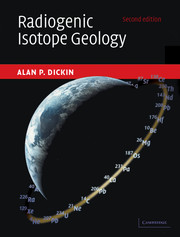Book contents
- Frontmatter
- Contents
- Preface
- Acknowledgements
- 1 Nucleosynthesis and nuclear decay
- 2 Mass spectrometry
- 3 The Rb–Sr method
- 4 The Sm–Nd method
- 5 Lead isotopes
- 6 Isotope geochemistry of oceanic volcanics
- 7 Isotope geochemistry of continental rocks
- 8 Osmium isotopes
- 9 Lu–Hf and other lithophile isotope systems
- 10 K–Ar and Ar–Ar dating
- 11 Rare-gas geochemistry
- 12 U-series dating
- 13 U-series geochemistry of igneous systems
- 14 Cosmogenic nuclides
- 15 Extinct radionuclides
- 16 Fission-track dating
- Index
8 - Osmium isotopes
- Frontmatter
- Contents
- Preface
- Acknowledgements
- 1 Nucleosynthesis and nuclear decay
- 2 Mass spectrometry
- 3 The Rb–Sr method
- 4 The Sm–Nd method
- 5 Lead isotopes
- 6 Isotope geochemistry of oceanic volcanics
- 7 Isotope geochemistry of continental rocks
- 8 Osmium isotopes
- 9 Lu–Hf and other lithophile isotope systems
- 10 K–Ar and Ar–Ar dating
- 11 Rare-gas geochemistry
- 12 U-series dating
- 13 U-series geochemistry of igneous systems
- 14 Cosmogenic nuclides
- 15 Extinct radionuclides
- 16 Fission-track dating
- Index
Summary
Osmium is the least abundant member of the group of six elements called the platinum-group elements (PGE). Like lead, osmium is an element with siderophile–chalcophile affinities, but unlike lead, osmium appears to be a strongly ‘compatible’ element during melting in silicate systems (meaning that it is strongly retained in the mantle source mineralogy). These geochemical properties mean that osmium can be used as a dating tool and a tracer in different ways from lithophile isotope systems such as Sr, Pb and Nd, providing unique evidence that complements these other systems.
Osmium has seven naturally occurring isotopes, two of which (187Os and 186Os) are the decay products of long-lived radioactive isotopes, 187Re and 190Pt. Of these two decay schemes, the Re–Os method has been used as a dating tool and geochemical tracer for over twenty years. 187Re has a half-life of about 42 Byr and makes up 62% of natural rhenium, a chalcophile element that behaves like molybdenum. The Pt–Os method has only recently been applied because the radioactive parent, 190Pt, has an extremely long half-life of about 470 Byr and makes up only 0.013% of natural platinum. This means that the natural variations in 186Os are extremely small and hard to measure. However, in combination with the Re–Os couple, the Pt–Os system provides unique information that justifies the effort of its analysis. Technically, 186Os is itself radioactive, but the half-life is so long that it can be considered stable for geological purposes.
- Type
- Chapter
- Information
- Radiogenic Isotope Geology , pp. 203 - 231Publisher: Cambridge University PressPrint publication year: 2005



